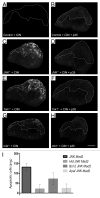JNK signaling is needed to tolerate chromosomal instability
- PMID: 24335260
- PMCID: PMC3988119
- DOI: 10.4161/cc.27484
JNK signaling is needed to tolerate chromosomal instability
Abstract
Chromosomal instability (CIN), as a common feature of tumors, represents a potential therapeutic target if ways can be found to specifically cause apoptosis in unstably dividing cells. We have previously shown that if signaling through the JNK pathway is reduced, apoptosis is triggered in models of chromosomal instability induced by loss of the spindle checkpoint. Here we identify components upstream and downstream of JNK that are able to mediate this effect, and test the involvement of p53 and DNA damage in causing apoptosis when JNK signaling is reduced in CIN cells. We show that cell cycle progression timing has a strong effect on the apoptosis seen when JNK signaling is reduced in genetically unstable cells: a shortened G 2 phase enhances the apoptosis, while lengthening G 2 rescues the JNK-deficient CIN cell death phenotype. Our findings suggest that chromosomal instability represents a significant stress to dividing cells, and that without JNK signaling, cells undergo apoptosis because they lack a timely and effective response to DNA damage.
Keywords: Drosophila; JNK; Mad2; apoptosis; chromosomal instability.
Figures





Similar articles
-
A dp53/JNK-dependant feedback amplification loop is essential for the apoptotic response to stress in Drosophila.Cell Death Differ. 2012 Mar;19(3):451-60. doi: 10.1038/cdd.2011.113. Epub 2011 Sep 2. Cell Death Differ. 2012. PMID: 21886179 Free PMC article.
-
A screen for selective killing of cells with chromosomal instability induced by a spindle checkpoint defect.PLoS One. 2012;7(10):e47447. doi: 10.1371/journal.pone.0047447. Epub 2012 Oct 15. PLoS One. 2012. PMID: 23077619 Free PMC article.
-
The genetic depletion or the triptolide inhibition of TFIIH in p53-deficient cells induces a JNK-dependent cell death in Drosophila.J Cell Sci. 2013 Jun 1;126(Pt 11):2502-15. doi: 10.1242/jcs.122721. Epub 2013 Apr 2. J Cell Sci. 2013. PMID: 23549790
-
Centrosome Dynamics and Its Role in Inflammatory Response and Metastatic Process.Biomolecules. 2021 Apr 23;11(5):629. doi: 10.3390/biom11050629. Biomolecules. 2021. PMID: 33922633 Free PMC article. Review.
-
[Cell cycle regulation after exposure to ionizing radiation].Bull Cancer. 1999 Apr;86(4):345-57. Bull Cancer. 1999. PMID: 10341340 Review. French.
Cited by
-
Autophagy regulates the survival of cells with chromosomal instability.Oncotarget. 2016 Sep 27;7(39):63913-63923. doi: 10.18632/oncotarget.11736. Oncotarget. 2016. PMID: 27590505 Free PMC article.
-
Chromosomal instability causes sensitivity to metabolic stress.Oncogene. 2015 Jul 30;34(31):4044-55. doi: 10.1038/onc.2014.344. Epub 2014 Oct 27. Oncogene. 2015. PMID: 25347746
-
Chromosomal instability as an architect of the cancer stemness landscape.Front Cell Dev Biol. 2024 Sep 13;12:1450614. doi: 10.3389/fcell.2024.1450614. eCollection 2024. Front Cell Dev Biol. 2024. PMID: 39345336 Free PMC article. Review.
-
Sterile inflammation in Drosophila.Mediators Inflamm. 2015;2015:369286. doi: 10.1155/2015/369286. Epub 2015 Apr 8. Mediators Inflamm. 2015. PMID: 25948885 Free PMC article. Review.
-
Co-Operation between Aneuploidy and Metabolic Changes in Driving Tumorigenesis.Int J Mol Sci. 2019 Sep 18;20(18):4611. doi: 10.3390/ijms20184611. Int J Mol Sci. 2019. PMID: 31540349 Free PMC article. Review.
References
Publication types
MeSH terms
Substances
LinkOut - more resources
Full Text Sources
Other Literature Sources
Molecular Biology Databases
Research Materials
Miscellaneous
